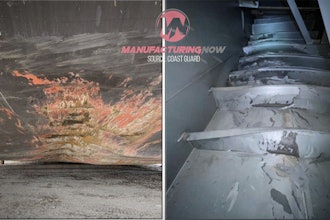Last January, the Qualifier 105, a small passenger boat, was stored at the Northern Enterprises Boat Yard in Homer, Alaska. The vessel was ashore and on blocks for the winter, but when it was in the water, it was used for everything from marine survey and oceanographic research to environmental clean-up.
Welders were aboard the 100-foot-long vessel performing some aluminum hot work, cleaning up the area around a fuel tank that was repaired and tested the day prior, when a fire broke out in a stateroom below the main deck.
Most Read on IEN:
- Jury Convicts Two Executives in Conspiracy to Fix Prices, Rig Bids, Allocate Markets for Concrete
- Automatic Ammo Vending Machines with AI Begin Operating at Grocery Stores
- Another Fatal Accident at Troubled Tank Cleaning Business
- The Boeing Supply Chain Gamble
The local fire department put out the fire, and no one was injured, but the damage was extensive and the vessel, which was about 54 years old, was declared a $1.2 million loss.
This week, the NTSB issued a final report following an extensive investigation and it turns out that it wasn't the welding that started the fire. Investigators found no signs of a fire after or while conducting the work even though the welders were working about eight feet away from the spot where the fire was first discovered.
Instead, the NTSB concluded the fire was caused by an undetermined electrical source that ignited a stateroom ceiling. The safety agency said the fire raged, and the damage was extensive because of the "substantial use" of combustible materials throughout the vessel.
While the NTSB "could not definitively determine that stray welding current caused the fire," the agency highlighted the precautions to take when stray welding current occurs in its final report.
Stray welding current happens when current goes through unintended conductors, like metal framing or wires, and back to the return terminal of a welding machine, which can cause fires by overheating wires.
To avoid potential fires, unlike this one, according to the NTSB, maintenance personnel should place the welding machine's work clamp (return current clamp) as close to the point of welding as possible--it's standard industry practice.
On the Qualifier 105, the welding machine work clamp was about ten feet from the point of welding during the hot work. The NTSB said the return current had to travel through the vessel's aluminum structure and/or conducting wires from the spool gun's electrode back to the work clamp.
It's possible that the aluminum structure could have served as a conductor, and the resulting current may have found its way into the vessel's electrical system, where an electrical wire above the stateroom could have served as an unintended conductor and become overheated, causing the fire.
But, there were also several wires and electrical boxes in the stateroom that may have been energized and become a potential electrical ignition source due to a fault. However, the vessel owner told the NTSB the boat didn't have any prior mechanical or electrical issues when it came out of the water.
Thus, the NTSB couldn't definitively determine that stray welding current was the exact ignition source.
Click here to subscribe to our daily newsletter featuring breaking manufacturing industry news.




















